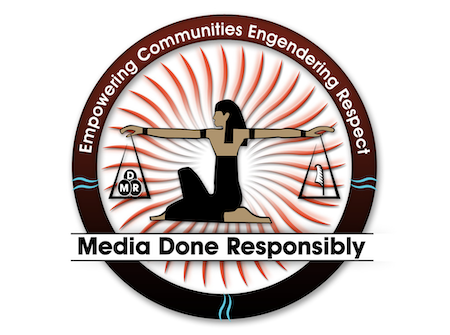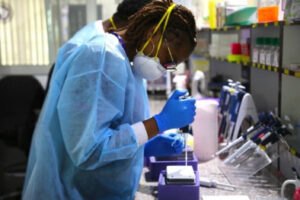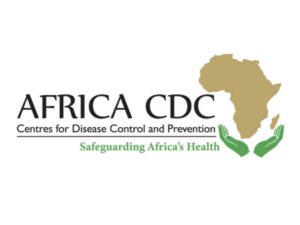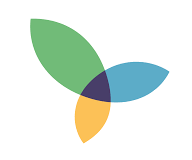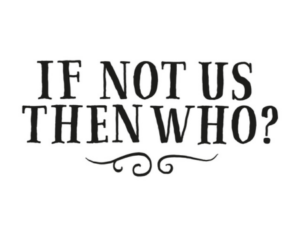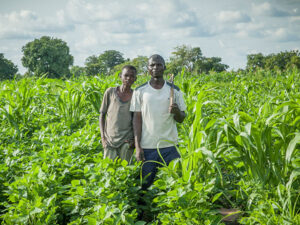Media Done Responsibly is helping young people understand the media they consume, including the harm of disinformation and stigmatizing narratives about marginalized communities, as well as the skills to advocate for media that reflects their humanity.
Shaunelle Curry of Media Done Responsibly spoke with Erica J. Edwards on April 13, 2023. Click here to read the full conversation with insights highlighted.
Erica Edwards: Could you please introduce yourself, your role and your organization, and the problem you work to address?
Shaunelle Curry: My name is Shaunelle Curry. I am the founder and CEO of Media Done Responsibly. The problem that we’re addressing is disinformation, especially as it pertains to marginalized communities. The work we do is to dismantle disinformation, to provide young people with the tools to understand all the media they consume, to give them the tools to create media from their perspective, and also to train them to advocate for media that respectfully reflects their humanity.
There’s a lot of conversation these days about misinformation and disinformation in news media, in social media, and some of it sometimes comes across as like, “This is a new thing with social media now,” but it is not a new thing at all. It’s just taking on a different form. A big part of the work that we do is to look at the ways in which marginalized communities have been put in boxes, the ways in which people who are in power have told stories of marginalized communities that are inaccurate, that lead to tropes, that lead to stereotypes and disempower those people who have many barriers around them anyway.
A few things happened back in 2007 when I first started thinking about this work. In 2007, I was an academic. I’m a teacher now as well. I’m a college professor. And at that time, I had an independent tutoring company and I was tutoring a family, a woman’s son. She was a single mom. She had an eighth-grader and a three-month-old. One day we were working in her home, it was in South LA, and a gang dispute started outside of her home. When this dispute started, the eighth grader jumped to the window. He wanted to see this. It was like stuff he saw on television and it was exciting. He wanted to see what was happening. The mom had been on the porch with her three-month-old. So she’s grabbing the baby in one arm, a little tricycle in another, and running in the house. I’m working to get her son back to the kitchen table, where we were working on math problems. I pulled him away from all of that excitement, and I sat there thinking, “Wow, there is literally no place in this house for them to go. There’s a little back room but there’s not a lot of space, so if any stray bullets were to run through, all of us could be in danger, but specifically this family.” Fortunately, that did not happen. The dispute moved on past us. I was able to get my student back focused on the work as if there weren’t more important things happening outside of his house. The mom spoke to me that day and she was saying, “Can you please help me get out of this neighborhood? I want to find schools for my son in other places where he could grow up and be safe.”
As I was leaving and I was thinking about this on my drive home, I turned on the radio just to kind of wind down, reflect. Every song that I heard on the radio was something about, “Drop it like it’s hot. Girl, I want to get you in the bathroom.” Anything that had to do with women. The only frame that women were discussed in was one that was sexualizing and misogynistic. And I thought, “Wow, what a contrast to the reality of this woman’s experience, where she is really doing the work to take care of her family, provide for them, and make sure that they have a safe environment.” Those are her concerns.
I thought, “Can’t we get a day of rest from this misogyny in the music?” That was one thing. Another thing that occurred in 2007 was shock jock Don Imus making a comment when he was officiating a game of the Rutgers basketball team. He called these women nappy-headed hoes. He said it in jest, and oh my goodness, the announcer, they just thought that was so funny. And it was extremely, extremely, extremely disrespectful. That’s a very light word. And I thought, “Wow, the way that Black women are represented in the media cannot continue, whether it’s music, whether it’s turning on a television show to watch a basketball game or to hear an announcement about that.” So I created this campaign at the time called Mother’s Day Radio to deal with that misogyny.
Long story short, we petitioned radio stations. We worked with young people in Los Angeles, in St. Louis, and in Chicago, throughout the US, to develop their own petition. These petitions said that we want 24 hours of music that honors our mothers, our daughters, our sisters, on Mother’s Day weekend and 24 hours of no misogyny whatsoever on the radio. This was back at a time before there was all the social media. They got handwritten petitions and they went around to their neighborhoods and they took these petitions with hundreds upon hundreds of signatures to the general managers of these radio stations and requested this. And they got a lot of pushback. They got producers saying, “This is what the people want to hear and so this is what we play.” And they’re saying, “We’re only asking for 24 hours.”
We were able to get, I think, three radio stations nationally. Stevie Wonder’s Radio Station, KJLH 102.3 in Los Angeles, a Philadelphia-based radio station, and then another 100.3 The Beat in Los Angeles. I thought that was going to be the end of the program. Then we had a panel where we brought 200 students together to talk about hip-hop and watched Byron Hurt’s film, Hip-Hop: Beyond Beats and Rhymes, which was groundbreaking. It really looked at the ways in which the media puts men in a box, Black men in a Box, and also women in a box. So at the time, I thought, “Okay, I did my work. This is going to be it. This is what we’re doing.” And the students that day, 15-year-olds said to me, “My mind, my eyes have been opened. We need to tell the story. I don’t know how to tell this story to my friends without coming off like I’m not cool or whatever. So can you bring us mentors? Can you help us tell this story?” And from there, Media Done Responsibly was born.
We started working with various universities. We built coalitions between universities, community-based organizations, local schools in the area, and have worked with over 25,000 young people from middle school through college age to become media literate, to begin to produce their own stories and tell their stories, and to advocate for media that responsibly represents them. This connects to this concept of disinformation because so much disinformation happens when we don’t have a platform to tell our own stories and other people are telling them.
Erica Edwards: What makes your approach distinctive?
Shaunelle Curry: What makes my approach distinctive is that we start with the voices of the young people, and through youth-adult partnership, we provide them with the foundation of a coalition. We have relationships with universities. We build relationships with the faculty. We build relationships with the administration. And we build relationships with the college students. We provide a peer-mentor program for the young people. We don’t go in and tell them, “Don’t listen to this on the radio,” or, “You should watch this,” or, “You should not watch that.” It’s not helicopter parenting. What we’re doing is providing them with near peers that allow them to think critically about the media that they’re consuming.
When we first started, there was Myspace. Obviously, social media has grown significantly since then, so they are inundated. They’re in these spaces where they don’t know how to navigate the technology. They don’t always know who owns the media, how the AI works, how they get stuck in certain media bubbles. They don’t necessarily understand the difference between reading a content marketing ad and reading a news article in the New York Times. They don’t necessarily understand the difference between an influencer or a celebrity posting on Instagram and sharing about their day versus them sharing an ad that is a sponsored promotion and so they’re telling you to buy this soap, this lotion, et cetera. It is not just about them sharing with you who they are.
We help them to understand that the media is a money-making industry and that there are a limited number of media companies that own all of the media. Understanding the motivation and the agendas of those owners, understanding all that they own and how that impacts them – unless they’re taught that, then they can’t engage with the media with a critical lens. We start from the space of their humanity, their story, the questions that they have, providing them with information that they may not have already known, making sure it’s engaging, and then we allow the youth to lead. We have mentors who then become trainers for other mentors who then become interns who then go through a school-to-career pipeline with the work that we’re doing.
Another big distinction in the work that we’re doing is the leadership. And I just want to be open and honest. It’s both a benefit as well as it’s led to some challenges and barriers. The agency is Black woman-owned, Black and brown woman run. This offers an experience to young people in marginalized communities to see leadership and to see themselves as future and current leaders, to see what is possible. And also to learn about the media’s influence and impact from a perspective that they might not hear otherwise.
If you have other communities that are talking about you being marginalized, usually, they’re looking at it through a different lens. Someone has either taught them that or there may be certain assumptions that they have, but they don’t necessarily have the full story because they don’t have the full experience. Someone like me and some of the other leaders have the full experience to be able to share with communities of like experience and provide solutions that are going to be relevant, that are culturally relevant to these communities. And I think that’s powerful.
I say it’s both a positive and part of the limitation because there are very few of us in the media literacy space. When we’re looking at funding – and unrestricted funding – there was a study done by Bridgeman and Echoing Green a few years ago that showed that Black woman-led agencies and organizations get less unrestricted funding than Black male organizations, which then get less restricted funding than any other organizations that are out there. There are all of these barriers to access and to growth. At the same time though, it’s such an enriching experience to have this perspective for the community that is impacted by the media in this way.
Erica Edwards: Can you share an example that illustrates the impact of your work?
Shaunelle Curry: Sure. There was a time we used to go into classrooms, pre-COVID when we could be in person. One of the things that we look at is cyberbullying and suicide, understanding the impact that being on social media, as well as the impact of being teased, harassed, and bullied online, has on young people. Our college students were doing a presentation with seventh-grade girls and during that presentation, one of the young ladies just burst out crying. And so, of course, they paused and wanted to be present for her, to create a space of listening and openness for her to share if she felt comfortable.
And so she did. She said that she had attempted suicide the year before when she was in sixth grade because of bullying online. It became a very sobering and powerful moment for all of them, especially for the trained mentors to be able to see in real-time that the work that they had done, the research that they had put together, the presentation that they had engaged the young people in, was very relevant. These are not just numbers anymore. I am looking face-to-face with someone who has been impacted. They were able to really hold space. They’re told it’s not their job to attempt to solve an issue. There’s always a classroom teacher that’s there and resources that can be provided, so they don’t have to become counselors. They are able to facilitate a very meaningful civil dialogue around it.
The trained university mentors were impacted. The young lady was impacted because, for the first time, she was able to share this story and be surrounded and loved by her peers and by these professional mentors who had come into the room to talk about it. She had a safe space to share her fears and her concerns and what she had gone through, her trauma. The other students in the classroom were also deeply impacted because one of the questions was, “Have any of you bullied anyone online?” And a majority of them admitted that they had. What they saw in that moment was the impact that it had. It wasn’t just teasing someone, but someone’s life was at risk. Because of proximity, it became very powerful and meaningful and helped them to understand the power of media. I say the media is like fire. It can warm you when you need it, but it can also burn you up depending on how it’s been used. They were able to really access and understand that in that moment.
Another example is we were working in South LA and we had two male-trained mentors who were working in a classroom. We had this exercise where students were paired up and they were told to think of a woman that they deeply respect and admire, and they would give the name of that woman to their partner. Then they were handed out a sheet of paper that had lyrics to a popular song at that time, Akon’s Smack That. The goal was to have fun but to also look at and interrogate some of the lyrics of songs that we listened to. They were given the lyrics, and of course, everybody started laughing. Their instructions were they could not sing the lyrics, they couldn’t do the beats and all of that because a lot of times we love the beat or the music. They had to read the lyrics aloud, and at certain parts of it, insert the name of their partner’s woman of honor. So not even their person that they selected. And let me tell you, a lot of these folks said “I can’t do this,” because they had selected their mothers, their sisters, somebody had selected their daughter, someone had selected Mother Teresa. You know what I’m saying? To hear those lyrics really put things in perspective and afterwards we would have a discussion about how it was for them. And the majority of them said that it was uncomfortable. Some of them said they couldn’t do it. They’re like, “I can’t put my mom’s name in this.” And the question was, “Why is it that most women of color are represented in this way? That this is the only way that they can be in a relationship with anyone is through hypersexuality and/or as an object for someone else’s desire through the lens of someone else?” That led to a very deep discussion.
In one of the sessions where I mentioned two young men were leading it, two trained mentors. a gentleman came in and the students had let us know he was gang-affiliated. He came in hard. He came in laughing like, “What’s this mess you all are doing?” So he came in really loud. That was how he started, so one of the mentors pulled him aside and he did that activity with him. You talk about a total and complete turnaround and transformation. At that moment, he got so quiet. And when we had our discussion after, he was the most vocal saying, “We need to make changes because they can’t continue to disrespect the women in our lives like this.” This was the same guy who just walked in with his whole persona, but the exercise really triggered and touched something within him. Young people are so intelligent and brilliant, and they don’t have to be taught at. Present them with the information. Let them make their decision. Train them how to think critically about these things and they will take it from there.
There are also the ways in which we’ve built a community around the organization. We have people who started off 10 or 11 years ago who continue to come back to volunteer, who continue to come back to work and be hired with the company because they believe in it and they are passionate about it. Especially with the shifts now in media and social media, we currently delve into AI, understanding media bubbles, understanding disinformation, finding and teaching them key tools in understanding how to identify media that is accurate and from a solid source versus media that is, a hacker has come in and created this story or dropped this misinformation or disinformation. We’ve expanded beyond music to include everything. I teach television, film, media studies, and journalism as well, and include solutions journalism in the work that we do.
Erica Edwards: Where do you teach?
Shaunelle Curry: I teach at California State University, Los Angeles.
Erica Edwards What insights or teachable lessons can be taken from your work that others could use?
Shaunelle Curry: I would say the biggest lesson is to build community around this media literacy component. And think of media literacy as an education tool, so the classrooms need to be involved. A big part of the work that I do is building these coalitions with universities so that we can take disinformation out of the ivory tower and bring it into the community. A lot of times, in academia, people can get stuck in the theories and the work of the academy – the papers, the books and all of the things. Disinformation really needs to be relevant and made accessible to community members, to young people, to those folks who are going to most benefit from it. Giving them access is powerful, so building those coalitions that have youth lead.
If you remember from my story earlier, it was the young people who told me what they wanted, and I built an organization around their needs. And I’ve continued to do that. I’ve continued to listen to them. Any kind of changes that have needed to be made, their voice has been at the forefront of that so that they have ownership of the work. They have guidance from the adults, they have a platform and resources because we offer it to them, and we provide them with training. They take it from there.
One of the big lessons in that is that young people are leaders today. We used to say young people are leaders for tomorrow. But they’re leaders for today. They’re the ones who come with that passion. They’re the ones who advocate. They’re the ones who are beating the pavement and bringing about systemic change. Creating partnerships with these humans is critical and it’s important.
Erica Edwards: How do you measure success? And what is the evidence that you’re making progress?
Shaunelle Curry: I measure success through story, through longevity, through the amount of access that we’re able to provide. We’ve worked with three major universities in Los Angeles and with over 35 schools and out-of-school time programs, and built a coalition with them. We have been able to impact over 25,000 young people throughout the years in the program. That data, those numbers, show a level of success. But I think it’s the stories as well. The stories of young people who have stayed in school because of our program. The stories of young people who have found a career and who are starting their own journey of social entrepreneurship because of the modeling and the leadership training that they have received through Media Done Responsibly’s Leadership Development Training program.
Also, there is the community that has been built, that helps to support mental health when young people are dealing with anxiety. We have civil dialogues and conversations that foster listening and that support authentic sharing. That is something we’ve heard about in many stories from our young people, and even have a video on those stories. The ways in which they’ve learned from that process, and the ways in which they have dealt with social anxiety through that process.
I would say another show of success is the requests that we’ve had for our curriculum. People from Africa, from Canada, and from other countries have wanted to utilize our curriculum in their spaces. For the longest time, we have not had the mechanism to do that. Right now, we’re pivoting in the organization so that we can provide certification training globally, so that we can provide curriculum, so that we can train other communities to be able to build these coalitions between their local universities, their community-based organizations, their local schools, to really be advocates for media literacy, media production, and media justice advocacy where they are.
Erica Edwards: Every social change model has strengths and limitations. What do you see as the main limitations of your work?
Shaunelle Curry: One of the big limitations has been lack of visibility, which I think stems from lack of access, which then, there’s this cyclical issue of lack of funding that also happens. That goes back to my conversation about Black women-led organizations having less access to unrestricted funding. I have a T-shirt that says, “Trust Black Women.” And that rings true for philanthropy as well. I’ve gone through all of the different programs, Grantsmanship training, Annenberg Alchemy. I’ve been on stages in front of thousands of people pitching so many things. I’ve been in many rooms, and I think it’s important to understand that sometimes even with all of that, all of the training, all the knowledge, all of the best practices, because of who we are, we are still sometimes the last to get the level of unrestricted funding.
There’s this bias. I just had conversations with some of the school staff and they were in agreement that that’s a shift that has to happen within philanthropy, and something that is slowly being worked on. But who are people going to trust? They’re going to trust people that have been in their network for a long time. They’re going to trust, essentially, a lot of times, white men, male-led organizations first, unless there is a very concerted effort to do the outreach and to build bridges and to be inclusive and make sure that there are pathways for communication and communicating well with diverse communities.
It’s not just about we’re going to get people who are from the LGBTQIA community and not learn how to talk to them, not learn what the basis of their needs are, or the perspectives that they come from. We need to make room for them. Communities of color, differently abled communities, really making space for these folks to sit at tables and shift the culture. Not just sit at tables and continue with the status quo.
When we bring those people to the table of philanthropy, then a door can open and conversations can be had. And we can begin to see the value in leaders that are doing this work. So in the media literacy space, there’ve been a couple of issues. One, for a long time, people didn’t understand what media literacy is. So you either were a media production organization or you were an education organization, but there was no frame for understanding this mixture of media literacy. When there was a shift in governance and all of the conversation around “false news,” then people were like, “Oh, media literacy. Yes, we do need that.”
Now people get it, and there’s this frenzy for media literacy. My organization has been doing this for 10 years at different levels. At this time, it’s like, “Talk to the people who are experts in this field, and let’s get this work done. Let’s fund this work. Let’s change policy so that a media literacy curriculum is something that is embedded into the curriculum in K-12 schools, and then at the university level as well.” All of that has been this tornado, hurricane that’s happened that we’ve had to get through.
Now we’re in these stages of setting a clear framework for what media literacy is so it can be understood, so that it can connect with the requirements for education. From my perspective, and from the perspective of a few other leaders of color and women who are leading this charge, making sure that there is room for our voices to do this work so that the work is also culturally responsive is important. That is a very unique perspective and we can’t just provide the same media literacy instruction and tools for everyone and “whitewash” it or not really address the systemic bias and prejudice that is very often baked into the media and baked into AI.
Erica Edwards Can you describe a mistake or failure that occurred in your work, and most importantly, what lessons you learned from it that others could benefit from hearing about?
Shaunelle Curry: It’s interesting because all of the things that I thought of as mistakes at the time, I can now look back at them and say, “Oh, that was a lesson that I needed to go through in order to get me to where I am right now.” But I would say this for other people to not have to do some of the same things that I did.
If you are a minority-led or a member of a marginalized community leading a new organization, do understand that it takes time and effort, and money. I would say build a coalition and build money first before starting a program. Build your strategic plan and seek funding for it first. As opposed to what we did and what a lot of people do is when they see a need, they jump in. They put their own money into it and they feel like, “Okay, I’ll raise money along the way to supplement that.” Well, it doesn’t always work out like that right away. I ended up putting my own money in it for longer than I should have, and had I known better, I would have sought out funders and seed funding first to get started.
There are really two businesses. There is the business of the work for the community and there’s the business of the financial business to sustain that work in the community. For me, that was my biggest aha, my biggest lesson. I mentor other founders, other executives, and other agencies, so that’s one of the things that I say to them, “Make sure that you start from that place so that you’re supported.”
Erica Edwards: Are you working to advance system-level change in your field? If so, how specifically are you doing that?
Shaunelle Curry: Yes, I do that through coalition building and partnership. I think it’s important to really pool resources but also to provide unique perspectives and bring all of those perspectives to the table. I think magic happens then. So it’s not just me coming to the table with my idea of what I think is going to change the world. But me coming to the table, and then me bringing my constituents to the table and saying, “Well, what do you think is going to change the world? And what is it that you need and how can this look for you?” We bring university partners that are passionate about community engagement, who want to connect the classroom learnings into a service learning model that allows college students to then do the work in the community.
As I mentioned earlier, with the work that we do, they see the impact immediately. I’ve had students say this was a different experience for them than if they were going to a soup kitchen. Not that they should not do that as well, but the way in which they saw the work that they put into this, it impacts lives, and they can see that transition happening within them and within the young people that they’re working with. It has been life-altering and inspiring for them to understand that they make an impact. I’ve had students come back and say, “I decided to go into law because I was so passionate about making change and being a part of your program inspired that.”
Training other communities to be able to build something similar that is sustainable, I think that will help to make systems change. Also, working with policymakers, and we haven’t done direct work with policymakers. We’ve done a kind of third-party connection. Working with the National Association of Media Literacy Education, working with local government offices that are looking for media literacy education for schools. Connecting in those types of ways with people from various sectors coming together to address disinformation and misinformation and looking at that broadly, looking at that through a cultural lens as well, is going to be an important part of systems change.
That’s a big part of why I think it’s important to have those voices represented. Because if they’re not at the table, if communities of color, LGBTQIA, differently abled communities are not at those tables, then you can end up having a very neutral or watered-down version of media literacy or media literacy change. In the end, that’s not going to be effective. The bottom will fall out because some of these major issues around inequity won’t be addressed. It’s important to build coalitions to bring everyone to the table in the beginning. So this work can be positively affected.
Erica Edwards: What do you think is most needed from partners to advance system-level change?
Shaunelle Curry: A willingness to listen to diverse voices and to give power, allow room, move over is what I would say. Move over and allow room for diverse partners to have space and agency and voice when making decisions about what media literacy is, what it looks like, what makes it up. I have had wonderful partners who have done just that. People ask me, as an expert, “What is needed? In what ways can we help or support? How can we build a win-win? What bridges can we make?” When you start from that point, it’s actually very exciting. It’s fun. It’s innovative. We’re willing to do the work together. I think that’s important. Remove some of the barriers. Remove some of the bureaucracy.
I think that’s important, especially for organizations and agencies that may not have the same capacity. They may not have a staff of folks who are doing fundraising and who are dealing with all of the paperwork, et cetera. They may have one or two people who are wearing multiple hats. By removing some of the steps, removing some of the bureaucracy to get to partnership in the first place, and then to take on some of the load, that is going to be an effective way to make a sustainable partner.
A lot of times there are programs that teach board chairs and executives how to do the work, but if the staff support is not there or if the capacity is not there to do all of those things, we also need support in someone else taking on some of that burden and working together. Shifting the frame of what partnership looks like and being able to share the burden with one another.
Erica Edwards: How do you see your work evolving over the next five years?
Shaunelle Curry: In the next five years, I see the work being replicated in multiple countries throughout the world and also multiple states throughout the United States. I think we have built an excellent model. And I am working on a book that’s going to share the journey of building this program, how to create a JEDI-focused community-based program that works — JEDI, meaning justice, equity, diversity, inclusion focused. Building coalitions between youth and community and university really puts media literacy at this forefront.
I’m working with Cal State Los Angeles right now on developing a certification program for teachers and educators to go through, to do the program and to build that in their communities. I’m working with the Global Digital Wellness Institute to work with community-based organizations and leaders to do the same thing and to build these coalitions with universities and expand this program. So that’s our goal. To decentralize, have it in different locations, provide people with best practices and support systems so that the work can spread.
Erica Edwards: Thank you so much for all the work that you’ve done, Shaunelle, and all the work you’re going to continue to do.
Click here to read the full conversation with insights highlighted.
Erica J. Edwards is a multimedia journalist based in NYC. She has worked at New York Public Radio, WTAE, WMUR, and the Mayor’s Office of Media and Entertainment (MOME). Edwards was a LEDE Fellow within the Solutions Journalism Network. She is deeply passionate about bringing solutions journalism to the forefront of the public’s news diet through social media.
* This interview has been edited and condensed.
Find other organizations working on media literacy to combat disinformation.

